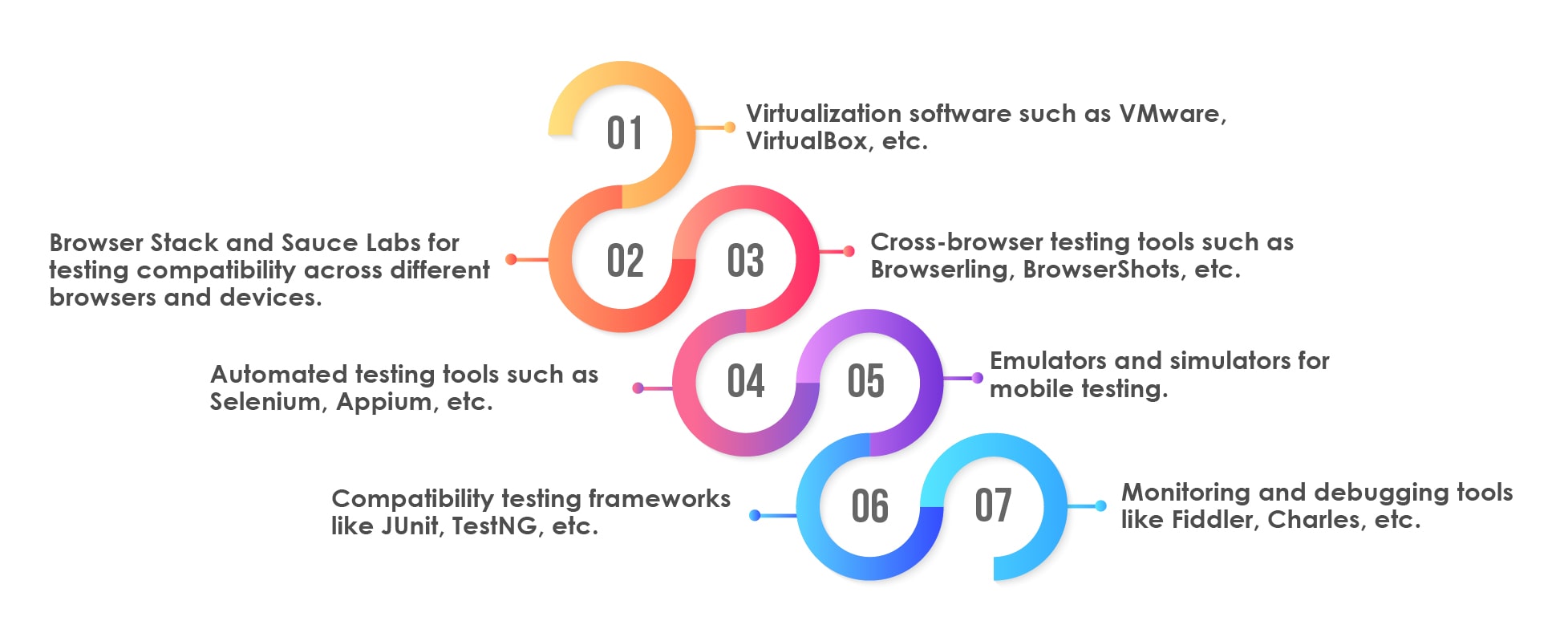Recommended Blogs
Compatibility Testing – An Integral Part of Digital Transformation

Content
- What is Compatibility Testing?
- Applicability of Compatibility Testing in the digital era
- Advantages of Compatibility Testing during digital transformation
- The key tools used for Compatibility Testing
- Steps Involved in Compatibility Testing
- Conclusion
- TestingXperts expertise in regard to Compatibility Testing
According to Gartner, 91% of businesses are engaged in some kind of digital initiative, and 87% of senior business leaders say digitization is a priority.
The numbers clearly depict how the technology domain is changing drastically. In an era where every aspect of our society and economy has been fundamentally transformed, the opportunity is greater than ever. If we think about it, every service will have digital areas associated with it. Therefore, the need to execute a digital transformation strategy has made different facets of software testing critical. And compatibility testing stands at the core of digital transformation strategy.
For definite reasons, it is not easy to evaluate each user’s choice, but it is definitely possible to make sure that a website is functional across multiple browsers available to the users – on both desktop and mobile devices. A situation like this makes it important to perform a compatibility test before deploying any application.
A brief on Compatibility Testing
It compares and reviews application functionality and styles across different browser platforms, operating systems, and mobile devices to recognize potential inconsistencies. This non-functional testing ensures entire customer satisfaction as it authenticates if the application performs as expected across all the platforms.
The compatibility of a system, application or website is built with different factors and objects, like databases, web browsers, operating systems, hardware platforms, mobile devices, users, networks, etc. It is conducted on the applications to assess their compatibility in multiple environments. It can be done manually as well as through automation tools.
Applicability of Compatibility Testing in the digital era
Compatibility Testing is important to test and ensure that the application doesn’t fail to perform as expected across any device or browser. It stays responsive on all the main browsers, devices, and operating systems. To meet the convenience levels, many enterprises with direct user-connect develop different applications for the users, that are required for the eCommerce and banking sector to reach out to the customers. An application basically passes through different facets of compatibility testing. For instance, if it is hardware, compatibility testing is performed to ensure that the software works without flaws across diverse hardware configurations.
While testing across operating systems, the tests check the application’s compatibility across different operating systems like Mac OSX, UNIX, Windows, and all contemporary OS. Compatibility tests are run to check the application’s performance across different versions. This is referred to as background Compatibility Testing and Forward Compatibility Testing.
Compatibility testing has become increasingly important in the digital era due to the growing number of devices, browsers, and platforms that users interact with. With the rise of bring-your-own-device (BYOD) policies and the increasing use of mobile devices to access the internet, it’s crucial that websites and applications are designed to function consistently across a wide range of devices and platforms. Compatibility testing helps ensure that digital products are accessible to users regardless of their device or platform, which can improve the user experience and reduce frustration.
Additionally, compatibility testing helps ensure that software is secure and performs optimally on different devices and platforms. This can reduce the risk of security vulnerabilities and technical issues, which can have a negative impact on user experience and brand reputation.
Overall, compatibility testing plays a vital role in the digital era by helping organizations deliver consistent and high-quality experiences to users across a wide range of devices and platforms.
Advantages of Compatibility Testing during digital transformation
To attract more users and keep them as loyal customers to your software or app, it is important to go beyond their expectations and make that can work well on different operating devices and systems. Compatibility test checks the responsiveness of any application and ensures it is meeting user demands while achieving functional success, Entrepreneurs and developers target to achieve a non-disrupted relationship with their users.
Compatibility Testing plays a vital role in building up the basics of digital transformation in the following manner:
Resolve Issues in Time
It helps rectify mobile/web application issues earlier instead of finding them post-launch to the customers. This reduces the efforts for customer support to address compatibility issues for a device, a browser version or an operating system. When the compatibility test is done, it helps resolve the issues ahead in the development cycle.
Enhances Software Development Process
Referring to the earlier point, compatibility testing checks the issues with the application in the development process itself. This betters the software/application quality on the go. The testing reveals a lot about an application: the application’s stability, scalability, and usability across different platforms and configurations. With digital transformation, the exact presentation of the application to the users is critical. Therefore, the development process needs to be comprehensive, and compatibility testing makes it sound.
Quick Error Fixing
When dealing with web and mobile applications, it is beneficial to recognize and fix performance issues without delay. Difficult areas must be spotted timely and corrected before the app even launches. Thus, compatibility testing assists in producing high-performing apps without any vast budgets.
Meeting User and Business Expectations
The key objective of digital transformation is to meet the never-ending demands of businesses and users. Implementing different compatibility tests helps ensure that the application meets the fundamental demands of the customers and offers the required customer experience. Thus, the application is optimized for offering quality. In fact, it has been analyzed that well-tested products lead to enhanced customer satisfaction.
Additionally, it examines and confirms that all software users or applications enjoy similar experiences across multiple platforms. Nevertheless, in their computing environment, the experience is uniform and seamless. This ultimately helps in having a long-lasting business outcome.
Enhanced Productivity
With increasing user demands and growing business requirements, compatibility testing plays a vital role in digital transformation. To increase the productivity factor and keep the users busy, the fundamental demands of the users should be met, and the users need to have a positive experience beyond their expectations. Compatibility testing makes sure that the app is upgraded and capable to deliver well-tested products with better quality.
The key tools used for Compatibility Testing

There are various tools used for compatibility testing, some of the popular ones are:
• Virtualization software such as VMware, VirtualBox, etc.
• Browser Stack and Sauce Labs for testing compatibility across different browsers and devices.
• Cross-browser testing tools such as Browserling, BrowserShots, etc.
• Automated testing tools such as Selenium, Appium, etc.
• Emulators and simulators for mobile testing.
• Compatibility testing frameworks like JUnit, TestNG, etc.
• Monitoring and debugging tools like Fiddler, Charles, etc.
It is important to note that the appropriate tool depends on the specific compatibility testing requirements and constraints.
Steps Involved in Compatibility Testing
Effective compatibility testing shall include the following steps:
• When testing with limited resources, a matrix of test cases shall be prioritized. Until your business’s reasons demand various types of compatibility testing, test cases relevant to the bigger segment of end-users shall be considered while considering the market shares of OSs, hardware platforms, and browsers.
• Real software requirements shall be considered to recognize the scope of different Operation systems, minimal hardware configurations, platforms, and peripherals of the expected operating area of the product. A few adjustments may be required to optimize the test case numbers against the desired platform coverage currently.
• When starting the testing, required testing resources like capable test personnel, hardware platforms, OS installation media, and related peripherals must be ensured. Cloud testing services, that are proficient in offering test platforms and testing tools can also be involved if needed.
Conclusion
George Westerman states, “when digital transformation is done right, it’s like a caterpillar taking the form of a butterfly, however, when done wrong, all you have is a really fast caterpillar.” Compatibility Testing is very important for building the reputation and stature of the brands, which is at the core of digital transformation. In conclusion, compatibility testing is essential for ensuring that software applications perform optimally and meet user expectations, regardless of the environment in which they are used.
TestingXperts expertise in regard to Compatibility Testing
TestingXperts’ comprehensive compatibility testing services are applied across multiple browsers. Hardware, databases, multiple configurations, etc. Additionally, our end-to-end cross-browser automation framework, Tx-Automate, assists testers in ensuring that the application runs effectively on all the preferred browsers, offering a pleasant customer experience and successful application usage.
At TestingXperts, we have professionals taking care of the compatibility testing that covers the latest operating systems, peripherals, platforms, and hardware to ensure that your product performs over a huge range of technical specifications. We also help clients identify suitable browser/OS/device matrices that should be covered at a minimum for their application compatibility testing considering their business domain and the geography of the users.
To know more about Compatibility Testing, get in touch with us and build applications that can give you better ROI in the era of Digital transformation.
FAQs
It compares and reviews application functionality and styles across different browser platforms, operating systems, and mobile devices to recognize potential inconsistencies. This non-functional testing ensures entire customer satisfaction as it authenticates if the application performs as expected across all the platforms.
To attract more users and keep them as loyal customers to your software or app, it is important to go beyond their expectations and make that can work well on different operating devices and systems. Compatibility test checks the responsiveness of any application and ensures it is meeting user demands while achieving functional success, Entrepreneurs and developers target to achieve a non-disrupted relationship with their users.
Compatibility testing should be conducted during the later stages of development, before deployment, to ensure seamless functionality across various devices, operating systems, and network environments.
Compatibility testing evaluates a software’s performance across multiple platforms, devices, and network conditions. Cross-browser testing ensures a web application functions correctly across different browsers and their versions. Compatibility testing has a broader scope, covering both hardware and software environments.
Discover more
Stay Updated
Subscribe for more info

